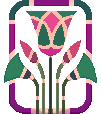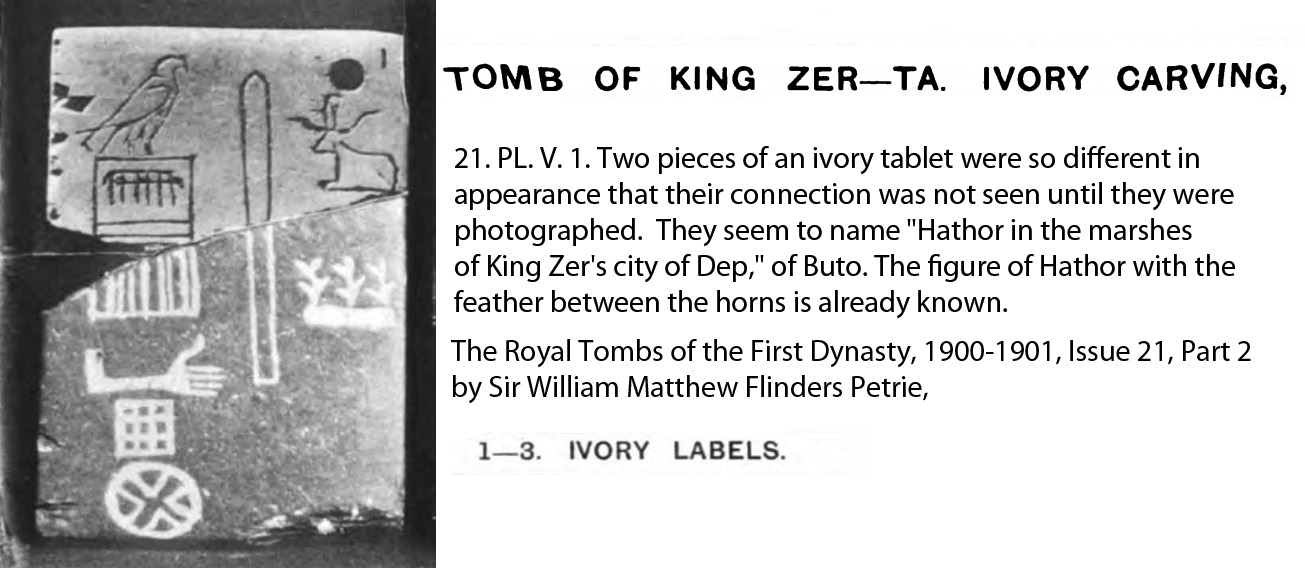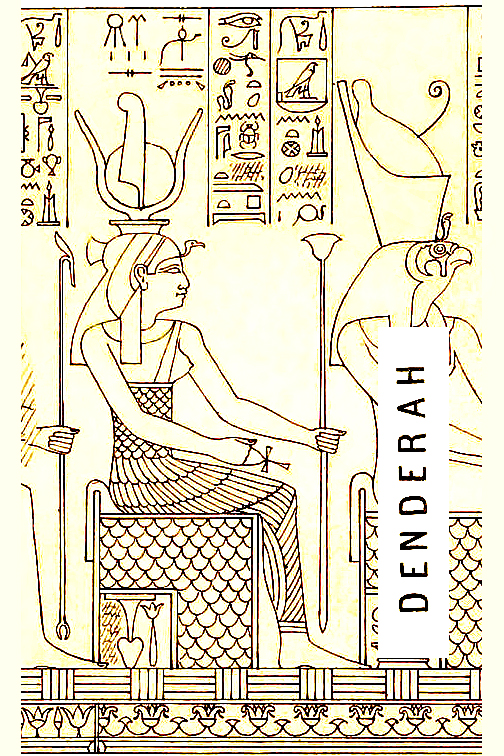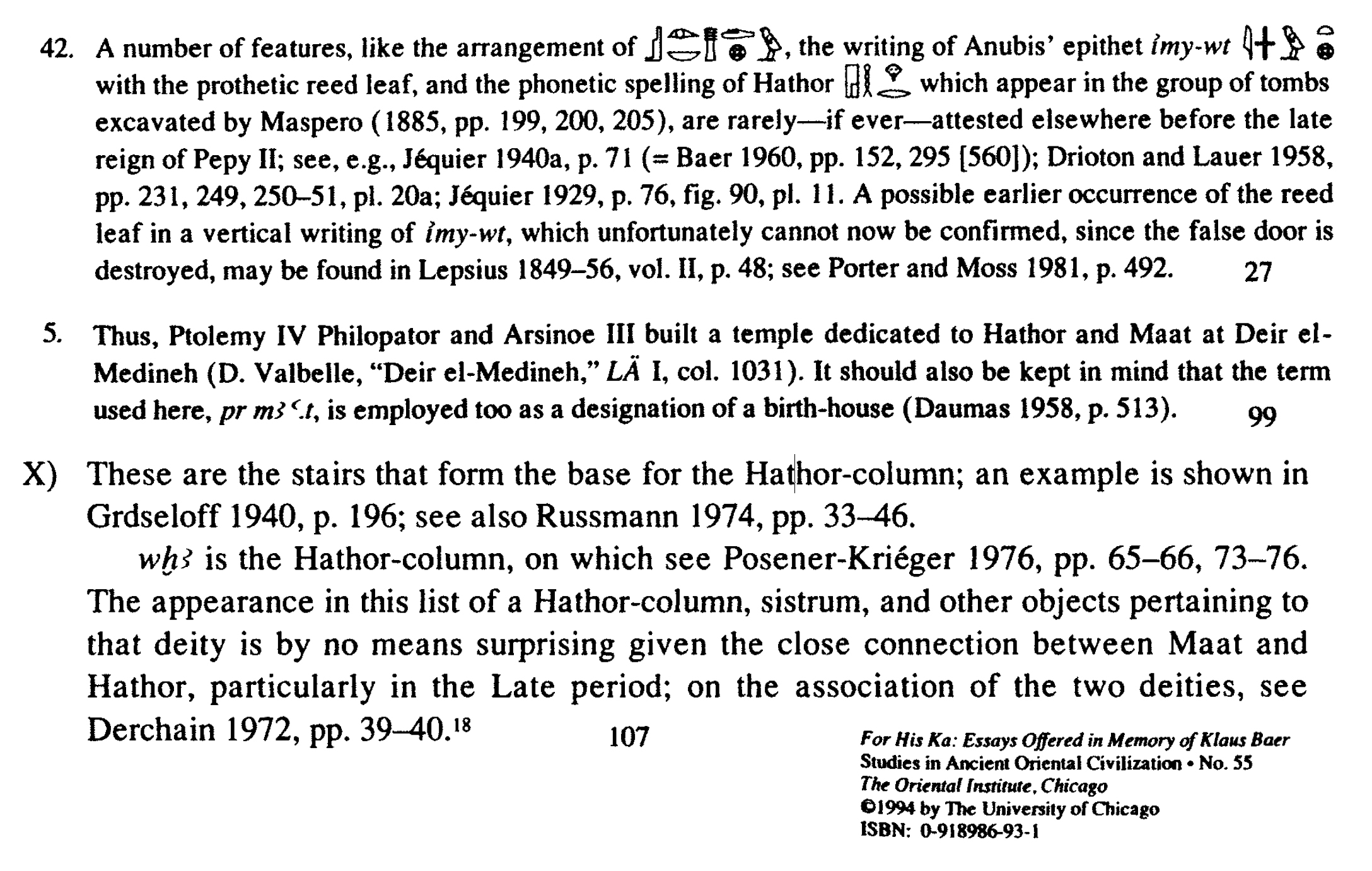
Then I got distracted and ended up taking whatever pdf book I came across in my saved files and searching for "Hathor". The book was SAOC 55, _For His Ka: Essays Offered in Memory of Klaus Baer_. I learned of another way in which Hathor might be referred to:

The phonetic spelling of Hathor (Footnote 42, page 27)
"Ptolemy IV Philopator and Arsinoe III built a temple dedicated to Hathor and Maat at Deir el-Medineh..." (Footnote 5, page 99)
There is a "close connection between Maat and Hathor, particularly in the Late period; on the association of the two deities, see Derchain 1972, pp. 39-40." (page 107)
I found Philippe Derchain's book title in a list of references: _Hathor Quadrifons: Recherches sur la Syntax d'un Mythe Égyptien_. Written in French! I was luckily able to find a copy, but it's written in French. (Insert pouty face :( ) So I brought up the reverso.net page and got to work. Fortunately, the text allowed copy and paste, and the character recognition on it wasn't too bad. Between reverso.net and my high school French studies, I was able to hammer out something meaningful, but am breaking it up a bit spacewise for better digestion:
"Ce parallélisme de Maât et de Hathor montre que les deux déesses doivent remplir les mêmes fonctions, qu'elle sont en quelque sorte deux désignations ou deux aspects d'une même puissaance." (page 39)
"Leur équivalence peut encore être mise en évidence par la comparaison de deux vignettes de papyrus dits mythologiques de la 21e dynastie qui représentent l'un et l'autre la barque solaire au moment de sa réapparition matinale, comme l'indique l'hymne au soleil levant qui accompagne l'une et la forme de scarabée ailé qu'on a donnée au dieu soleil dans l'autre31."(pages 39-40)
"Or, à la proue de la barque se tiennent chaque fois deux déesses. Dans le papyrus de Neskhons, elles sont identiques et le disque entouré de cornes de vache qu'elles portent sur la tête les désigne comme Hathor. Dans le papyrus de Djedkhonsefankh au contraire, la première figure es Maât, reconnaissable à la plume piquée dans sa chevelure, la seconde Hathor parée comme dans l'autre papyrus. L'identité de fonction des deux couples de déesses indiquée par leur position impose la conclusion que Maât et Hathor sont considérées comme deux signes interchangeables." (page 40)
"Le groupe plus précis du papyrus de Djedkhonsefankh correspond à la description la plus précise de la barque solaire, à la proue de laquelle les deux déesses se tiennent dans d'autres circonstances, comme dans cette liste héliopolitaine d'une inscription du Ramesséum 32 où Maât et Hathor figurent en tête du groupe des divinités qui prennent place à l'avant de la barque solaire." (page 40)
"La duplication de Hathor dans le papyrus de
Neskhons ne peut être comprise qu'en admettant l'équivalence des deux déesses
dans leur fonction de pilote de la barque, la synonymie des deux signes dans la
description du régiment du monde.
Soit dit en passant, l'attitude de Maât que nous observons là ne fait que suggérer à l'oeil le sens profond de son nom qui devrait être "Celle qui guide",
selon une hypothèse très probable de Westendorf, sur laquelle je reviendrai plus loin 33." (page 40)
Footnotes
32 Pour une description générale de la scène se reporter à l'appendice p. 50-51 où on trouvera
aussi la bibliographie. Pour une photographie, voir la pl. 8. La liste des occupants de la
barque de Râ comprend Maât, Hathor, un dieu dont le nom a disparu presque complètement,
Hou, Sia, Khonsou, Oupouaout et Seth (Souty) maître de la vie, tous [Hat wia en Re'e], ce
qui doit signifier plutôt "à l'avant de la barque de Râ" que directement "à la proue" compte
tenu de leur nombre. Viennent ensuite les étoiles circompolaires et les planètes, enfin "ceux
qui ignorent l'obstacle, les voyageurs et les rameurs de Râ", figures dont on retrouve certaines au cours de la navigation nocturne du soleil (Hornung, Amduat, Agyptol. Abhandl. 7,
1963. Nos. 655, 659, = 9e heure).
33 Westendorf, Ursprung und Wesen der Maât, Festschrift Dr. Will, München 1966, 208 sq.
-------------------------------------------------------------------------------------
"Neskhons, wife of the high priest of Amun, Pinedjem II (c. 990=969 BC) in the late 21st Dynasty." (John H. Taylor, _Death and the Afterlife in Ancient Egypt_, (University of Chicago Press/British Museum Press 2001), page 116)
I did learn at least part of her papyrus is in the Cairo museum in this reference, "papyrus and tablet of Neskhons (Cairo 58032 and 46891) (Robert Kriech Ritner, _The Libyan Anarchy: Inscriptions from Egypt's Third Intermediate Period_, (Society of Biblical Literature 2009), page 506)
Ritner translates a "Hieratic wall docket recording the burial of Neskhons, Inscribed on the right door-jamb at the bottom of the tomb shaft":
This Djedkhonsuiuefankh and the Djedkhonsefankh to whom Derchain refers might be the same person. In which case the two examples that Derchain speaks about are likely done in a close time frame, possibly even by the same artist? While Hathor-Ma'at is definitely a syncretism in the Ptolemaic period, was this a common occurance in the 21st Dynasty?
As a further thing to add to the mystery, First Dynasty King Djer had an ivory tablet of which Petrie wrote about and shared a photo:
"The figure of Hathor with the feather between the horns", isn't that what we see in the Dendera image?
"The parallelism of Maât and Hathor shows that both goddesses must fulfill the same functions, that they are in a way two names or two aspects of the same power.
"Their equivalence can be again be highlighted by the comparison of two vignettes in mythological papyri of the 21th dynasty which represent both the solar barque at the time of its early morning reappearance, as the sunrise hymn indicates, which accompanies the one and the shape of winged beetle given to the sun god in the other one.31"
"Yet, the prow of the barque holds two goddesses every time. In the papyrus of Neskhons, they are identical and the disc surrounded by cow horns which they wear on their heads designates them as Hathor.
In the papyrus of Djedkhonsefankh on the contrary, the first figure is Maât, recognizable by the feather pricked in her hair, the second Hathor adorned as in the other papyrus. The identity of the function of both couples of goddesses indicated by their position imposes the conclusion that Maât and Hathor are considered as two exchangeable symbols."
"The more precise group in the papyrus of Djedkhonsefankh corresponds to the most precise description of the solar barque, to the prow of which both goddesses are held in other circumstances, as in a Heliopolitan list from a inscription at the Ramesseum 32 in which Maât and Hathor appear at the top of a group of divinities which takes place in front of the solar barque."
"The duplication of Hathor in the papyrus of Neskhons can be understood only by admitting the equivalence of both goddesses in their function of pilot of the barque, the synonymy of both symbols in the description of the regiment of the world. Incidentally, the attitude of Maât which we observe there is only suggesting to the eye the deep meaning of her name which should be "The One who guides", according to a very likely hypothesis of Westendorf, on which I shall return to later 33"
31 Piankoff~Rambova, Mythological Papyri, Bollingen Series 40, pl. 5 et 9.
"32 For a general description of the scene refer to the appendix p. 50-51 where we shall also find the bibliography. For a photo, see pl. 8. The list of the occupants of the boat of Râ includes Maât, Hathor, a god whose name has disappeared almost completely, Hou, Sia, Khonsou, Wepwawet and Seth (Sutekh) Lord of Life, all [Hat wia en Re'e] which has to mean rather "in front of the barque of Râ" than directly "at the prow" considering their number. Then comes the circumpolar stars and planets, at last "those who ignore the obstacle, the travelers and the rowers of Râ", figures which are certainly found during the course of the sun's noctural navigation. (Hornung, Amduat, Agyptol. Abhandl. 7, 1963. Nos. 655, 659, at the 9th hour)."
All that I can discover about Neskhons and Djedkhonsefankh are the following:
"Regnal year 5, month 4 of summer, day 21. (2) the day of burial of the chief of the noble ladies, Neskhons, (3) by the God's Father of Amon and overseer of the treasury, Djedkhonsuiuefankh, [son of] Pinedjem. (4) and the prophet of Amon-Re, King of the Gods, Ankhefenamon, (5)[and the elder] of the portal, Nespay[...], (6) and the God's Father of Amon and general, Nespakashuty. (7) The seals that are on this place [...]: (8) The seal of the overseer of the treasury, Djedkhonsuiuefankh, (9) and the seal of the treasury scribe, nes [...]" (Ritner, page 144)
"Two pieces of an ivory tablet were so different in appearance that their connection was not seen until they were photographed. They seem to name "Hathor in the marshes of King Zer's city of Dep," of Buto. The figure of Hathor with the feather between the horns is already known."

